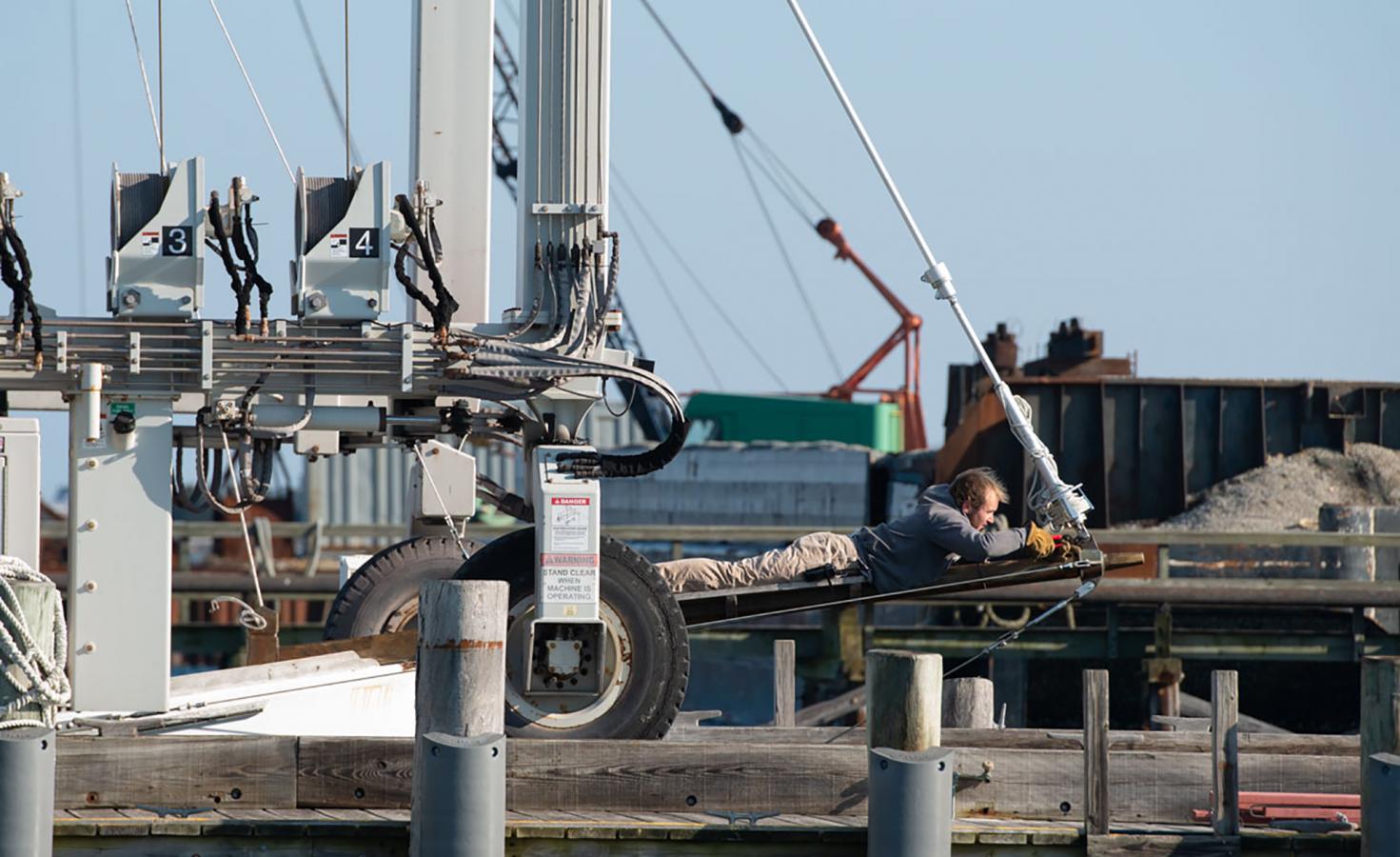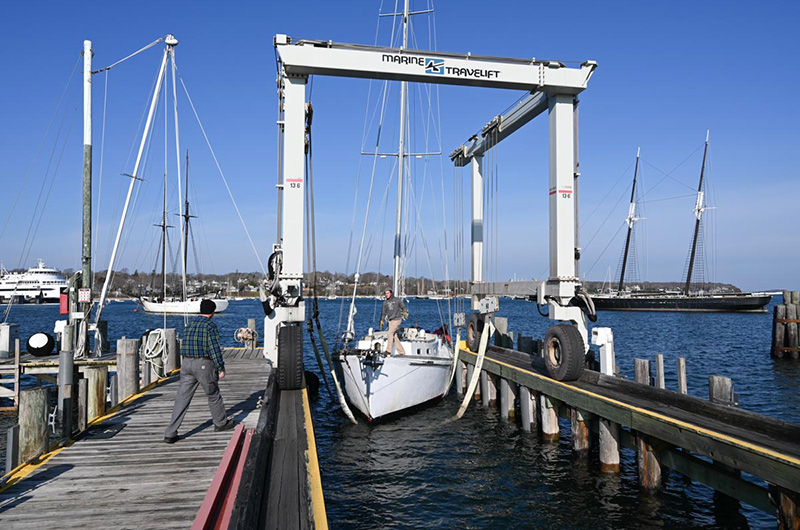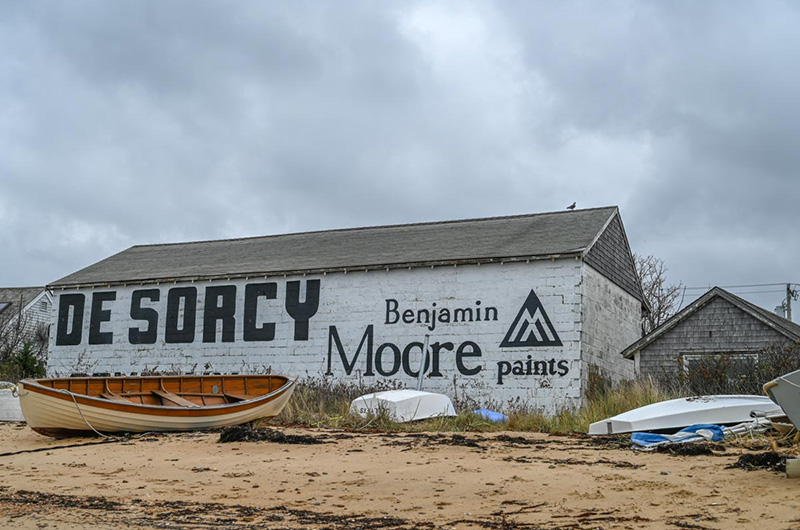Stretching from the Steamship Authority terminal at the north end of Water street in Vineyard Haven, to the R.M. Packer Co. on the far edge of Beach Road, is the only unimpeded, half-mile expanse of year-round working waterfront on the Island. The area is rife with docks, silos, slips and sloops. For some it is ugly. For others, it is barely noticeable. For all, it is vital.
And there is nowhere else on Martha’s Vineyard like it.
“Some people drive down the road and say, oh, there’s nothing going on there,” said Nat Benjamin, who co-owns the legendary Gannon and Benjamin boat-building business, while scanning the harbor from his dock. “Well, you’ve got to get out of your car and walk down to the water. Then you’ll see, oh my gosh. Boat-building, tugs, barges, boats being hauled, and stored, and moved, and repaired. It’s teeming with activity, all year round, and that’s what really gives a town vitality. This is where it’s happening.”
While the two other down-Island towns, Oak Bluffs and Edgartown, have over time replaced their working waterfronts with trademarks of a bustling summer tourist economy, like hotels, T-shirt shops, ice cream parlors and beach clubs, an overlay of unique zoning regulations signed into law in Vineyard Haven at the turn of the millennium have preserved the horseshoe-shaped section of Beach Road as the Vineyard’s one true port. It is a salty, sea-soaked figment of the Island’s maritime past — and a conspicuous reminder that it still has a maritime present.

Now, almost 20 years later, the small yet crucial section of Vineyard Haven harbor will be forced to contend with that present, as well as its maritime future. Facing the dual threat of a changing climate and a changing economy, a series of independent development projects along Beach Road are poised to move through the town and Martha’s Vineyard Commission’s arduous review process, both proving the importance — and potentially challenging the teeth of the Tisbury working waterfront zoning regulations signed 20 years prior.
The Martha’s Vineyard Shipyard, one of the oldest continuously operating businesses on the Island, hopes to add a 48-slip marina on the Lagoon side of their property as part of a larger redesign. R.M. Packer wants to add a marine terminal to his property for the proposed offshore wind projects. The state, with the support of the town, has drawn up plans to reconfigure Beach Road from Five Corners to the drawbridge, hopefully raising it by six inches, adding a continuous bike path and removing telephone poles. Stop & Shop consistently discusses expanding its Water street store, while real estate developers are eying a 40B housing project consisting of 72 residential units on the former site of Hinckley’s Hardware.
All the projects will face scrutiny from Tisbury planning and zoning boards, federal environmental boards, local shellfish and aquaculture advocacy groups, as well as the commission. All will have to comply with the unique zoning laws that have been in place for the past two decades. None of the projects would have been possible without them.
•
By 1998, historic coastal harbors across the Atlantic were disappearing. Newport, once with four or five boat building and repair operations, was down to one or two. Lobstermen in Maine and crab fishermen in the Chesapeake saw their docks replaced with small businesses that rented bicycles and kayaks to summer tourists. On the Vineyard, a particularly congested summer of jet ski rental businesses, seaplane landings and high-speed New York ferry dockings thrust the year-round working Vineyard Haven harbor into the spotlight, fostering debate about long-term growth in Tisbury.
“In simplest terms, how does the town assure that the things it wishes to happen in and around our harbor do, and the things it wishes not to happen don’t, so that Vineyard Haven Harbor will remain the jewel that it is?” asked chairman of the board of selectmen at the time, A. Kirk Briggs, in a letter to town counsel.
The letter also requested another lawyer to spearhead the effort to “develop clear, consistent, and defensible controls that will protect our harbor and the rights of those who enjoy it,” a 1998 story in the Gazette reported.
Mr. Benjamin was one of the town residents, and harborfront business owners, who hoped to preserve those rights. “A lot of us along the waterfront saw this as an endangered species,” he recalled. “We said, let’s put together some zoning regulations to preserve — to protect — the shipyards and working waterfront so they wouldn’t get squeezed out like it happens everywhere else in America.”
Throughout the summer of 1999, the town, led by selectman Ed Coogan, wrestled with ways to preserve the harbor, eventually deciding at a divided meeting to nominate the working waterfront as a district of critical planning concern — a special overlay zoning district allowed through the Martha’s Vineyard Commission. The commission unanimously adopted the nomination one year later. On Oct. 24, 2000, Tisbury voters overwhelmingly approved it at town meeting.
The special planning district was the first of its kind for a town harbor, preserving all waterfront development in perpetuity from the Eastville jetty to the Steamship Authority terminal. Today, the district is demarcated on town zoning maps with a ship’s wheel.
“The purpose of these regulations is to maintain and enhance the cultural heritage and economic vitality of the Vineyard Haven Harbor and waterfront,” the DCPC says in part. “Specifically, these regulations seek to maintain the Vineyard haven Harbor as a year-round working waterfront.”
The regulations include elegant wording about protecting the views of the waterfront, promoting maritime industry, sailing and boatbuilding, as well as shellfish and wildlife habitats, water quality, safety, navigational resources and marine recreation. The rules also allowed for a waterfront commercial district sandwiched between the harbor and Lagoon, with everything from movie theatres to restaurants to gas stations to the Pyewacks antique exotica store and tarot card reader.
Little has changed on the eclectic stretch of road in the 20 years since.
“The water dependent part of the area has survived. And that’s important,” said Ben Robinson, who currently serves on the Tisbury planning board and the MVC. “The fear was restaurants, condominiums, other sorts of seasonal economy pieces would increase the property values so that a working waterfront business would no longer be viable there. And this is what happens up and down the East Coast. But here they’ve been protected. It’s worked.”
Critics of the DCPC have focused on the extent of the restrictions, saying they prevent free-market development at the expense of niche, less profitable businesses — and forcing those businesses, like the Black Dog, to prove that their T-Shirt sales go toward things like educational charters on the schooner Shenandoah.

For Mr. Robinson, that was the idea from the beginning.
“Being able to balance these things that are always rubbing up against each other is difficult, that takes some careful planning,” he said. “And it shouldn’t be just arbitrary. You have to have it written down. That’s partly why that DCPC has been so successful. It has managed to protect what it set out to protect. If that means that other things weren’t allowed, then that was kind of the point.”
But with 2020 approaching, the tides are changing, both literally and figuratively. As a result, the planning board, as well as businesses and future developers in the area, are forced to prepare for new sorts of threats to the district and the shoreline that defines it.
By mid-century, most scientists predict the sea level will rise by one and a half to three feet. By 2100, the rise could be as high as 10 feet. Five Corners, one of the most consistently flooded intersections on the Island and vital to all off-season Steamship Authority traffic, is only five feet above sea level at its highest point. On average, it is between three and four feet above sea level.
“A lot of that area will be subject to tidal flooding on a daily basis,” Mr. Robinson predicted. “Everybody that develops down there will have to raise their property.”
The current developments slated for the area have listened. Philip Hale and his son James, owners of the Martha’s Vineyard Shipyard, plan to raise their property by 18 inches and add water permeable surfaces over areas that were once hardpan. And although Packer’s property represents the road’s high water point, the Tisbury marine terminal project will also include pile-supported pier structures and a wave fence to prevent storm surges.
“It’s a real puzzle. And you take sea level rise and climate change and pile it all on top of that, it’s even worse,” Mr. Robinson said. “It’ll be interesting to see how some of these projects evolve.”
The town has similar plans, and will conduct a coastal management zone study this winter to analyze the effects of sea level rise and climate change. There are visions of extending the Eastville jetty to help dampen aggressive storm tides. As oceans get higher, Mr. Robinson predicted that many businesses will have to retreat, potentially moving to the B2 business district along State Road. It is the town’s prerogative, as well as the DCPC’s, he said, to ensure that vital waterfront businesses, like the Steamship Authority, can continue operations.
“We are looking at the waterfront commercial district, first and foremost, to preserve the harbor. Because it is a vital piece of the Island infrastructure,” Mr. Robinson said. “And then, second to that, to manage the protection, accommodation and retreat because of sea level rise.”
Beyond planning for the effects of climate change, all the major developments on Beach Road will have challenges of their own to confront. The Martha’s Vineyard Shellfish Group has already submitted a letter of opposition to the state about the shipyard project, raising concerns about the Lagoon’s water quality and the impact that a dredging and marina expansion will have on vital shellfish resources. The proposed Tisbury marine terminal will have to expand over a barrier beach, causing an unknown effect on tidal flows. The former Hinckley property project represents a massive change of use, proposing 72 residential units in a commercial zone.
And of course, there remains the issue of aesthetics. When visitors arrive on the Steamship Authority, their first impression of the Vineyard is often not the stately homes of Edgartown or the cottages of Oak Bluffs — but the industrial stretch of working waterfront along Beach Road. For Mr. Robinson, though, that’s not a problem. In fact, it was something the DCPC was created to also preserve.
“A working waterfront isn’t supposed to look clean,” he said. “These marine businesses are not a house on North Water street in Edgartown . . . People get off the boat, and they are not confronted with a brand-new, Disney-fied welcome mat. They get a sense that they have arrived at a place that is authentic. They might not be fully conscious of that, but it does deliver a message to them that says, you are somewhere different. Pay attention.”
•
Nestled deep within the crook of Vineyard Haven harbor is the Gannon and Benjamin Marine Railway, a one-of-a-kind wooden boat building and repair shop that has hand crafted many of the finest vessels on the Eastern seaboard. The shop is filled with cataracts of sawdust and cabinets of curiosity, containing everything from paddle bits to plug cutters, planer knives to counter sinks, bronze nuts, brass nuts, “big nuts, weird nuts,” and “that one thing nobody can figure out,” in Mr. Benjamin’s words.
Gannon and Benjamin is the jewel of the Tisbury working waterfront. But 40 years ago, before working waterfront zoning laws even existed, it could have been a McDonald’s.
In 1978, the approximately one-acre beachfront property that now houses the boat shop was tapped as a perfect site for the fast-food chain’s first Island location. the Golden Arches saw a potential beacon for hungry tourists whose appetite — and pocketbook — may have preferred frozen Filet-O-Fish to fresh fish filets.
The Island, naturally, went apoplectic.
Scared their working waterfront would turn into “the honky-tonk Maryland or Delaware shore,” as one Gazette letter writer put it, residents fought back, organizing a Sack the Mac campaign and tirelessly opposing a town sewage amendment that would allow for development on the property. When the Tisbury board of health rejected the proposal, forcing McDonald’s to back down, Donald DeSorcy swooped in, purchasing the land one year after and leasing a waterfront portion to two washashores who wanted to build wooden boats on Martha’s Vineyard.
“We’re still here,” Mr. Benjamin said, four decades, and 93 original boat designs later.
Although the zoning bylaws went into effect 20 years after that, the battle over the McDonald’s set the tone for the preservation work to come. Mr. Benjamin felt his business wouldn’t have survived without the zoning. He described a “free-for-all” for waterfront property that would have led to unbridled congestion. Now, because of the working waterfront zoning bylaws, he isn’t going anywhere.
“Ross Gannon and I started the business on the coattails of McDonalds,” Mr. Benjamin said. “We didn’t want to see this become another moped rentals and fast food. We wanted to keep the working side of it . . . this traditional boat building, the maritime heritage, this is kind of the time warp on the waterfront here.” He added:
“It’s the only one.”
Gannon and Benjamin is also planning to expand on the harbor. When the DeSorcy property went on the market in July 2018, a community group formed with plans to raise enough money to buy it. Mr. Benjamin, who is part of the group, said he believes the effort will succeed, among other things allowing them to move their other shop, called Mugwump, to the water.
“What we’re hoping to do is lock up this section [the DeSorcy property], to preserve what we’ve started, and to expand it,” Mr. Benjamin said. “We want to put in more boat building. We want more working waterfront. That’s our hope. Our hope and our dream.”
That project too would be subject to zoning bylaws, and threatened by sea level rise.
Standing at the edge of his dock, Mr. Benjamin pointed toward all the businesses that straddle the sea. He described the Packer empire and the historic shipyard, the Black Dog marina and the hundred-foot schooners in the water. He laughed at the chain-link fencing surrounding the future Boch Park, while his workers labored over a restoring a 1932, 83-foot Alden sloop owned by a former secretary of state.
The sun was golden. The only arches in the harbor glistened on the water.
“This is the gateway,” Mr. Benjamin said. “We need it.”










Comments (20)
Comments
Comment policy »